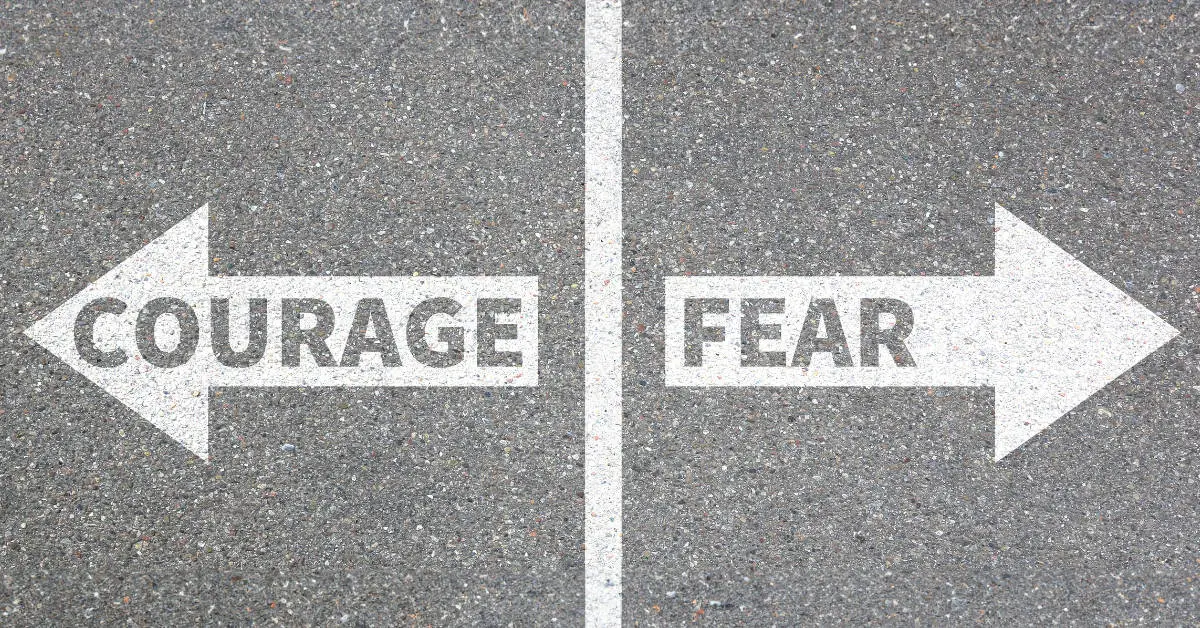How To Stop Living In Fear: Practical Tips For A Fearless Life
Living in fear can be overwhelming and can hold you back from living your best life. Fear and anxiety can manifest in different ways and can be caused by various triggers, such as past experiences, negative thoughts, and uncertainty about the future. However, it is possible to overcome fear and take control of your life.
Understanding fear and anxiety is the first step towards overcoming them. Fear is a natural response to perceived danger, while anxiety is a feeling of unease about future events. Identifying the triggers and negative thoughts that contribute to fear and anxiety can help you manage them better. With the right tools and mindset, you can learn to change your perception of fear and develop coping strategies to deal with it.
Taking control and action is crucial in overcoming fear. This involves facing your fears and taking small steps towards overcoming them. Seeking professional help, building confidence and courage, and maintaining your mental health are all important components of living a life free from fear. By implementing these strategies, you can learn to live in the present moment and enjoy life to the fullest.
Key Takeaways
- Understanding fear and anxiety is the first step towards overcoming them.
- Taking control and action is crucial in overcoming fear.
- Seeking professional help, building confidence and courage, and maintaining your mental health are all important components of living a life free from fear.
Understanding Fear and Anxiety
Fear is a natural emotion that arises in response to a perceived threat. It is a survival mechanism that helps us stay safe in dangerous situations. Anxiety, on the other hand, is a feeling of unease, worry, or fear that is often generalized and not necessarily linked to a specific threat. Understanding the nature of fear and anxiety can help you manage and overcome them.
Nature of Fear
Fear is a basic emotion that is hardwired into our brains. It can be triggered by a variety of stimuli, including physical danger, social situations, or even our own thoughts. When we experience fear, our body goes into a “fight or flight” response, which prepares us to either confront the threat or run away from it.
Direct and Indirect Fear
There are two types of fear: direct and indirect. Direct fear is a response to a specific, immediate threat, such as a car coming at you at high speed. Indirect fear, on the other hand, is a more generalized fear that is not linked to a specific threat. This type of fear can be more insidious, as it can creep up on you slowly and affect your daily life without you realizing it.
Anxiety Disorder: A Health Perspective
Anxiety disorder is a mental health condition characterized by excessive and persistent fear or worry about everyday situations. It is a serious illness that can significantly impact a person’s quality of life. Anxiety disorder can be an illness generator, leading to other physical and mental health problems if not treated properly.
If you are experiencing fear or anxiety that is affecting your daily life, it is important to seek professional help. A mental health professional can help you understand the nature of your fear and anxiety and develop a treatment plan that works for you. Remember, fear and anxiety are normal human emotions, but they should not control your life.
Identifying Triggers and Negative Thoughts
Living in fear can be a debilitating experience that can impact your life in various ways. Identifying your triggers and negative thoughts can be the first step towards breaking free from this cycle. Here are some tips to help you recognize and address your triggers and negative thoughts.
Recognizing Triggers
Triggers are events or situations that can cause fear and anxiety. They can be external or internal and can be different for each person. Some common triggers include social situations, financial stress, health problems, and traumatic experiences.
To recognize your triggers, you need to be aware of your thoughts and emotions. Pay attention to how you feel in different situations and try to identify the events that cause you to feel anxious or fearful. Keep a journal to document your thoughts and feelings, and look for patterns to identify your triggers.
Addressing Negative Thoughts
Negative thoughts can be a major contributor to fear and anxiety. They can be automatic and may not reflect reality. Addressing negative thoughts can help you change your perception of situations and reduce fear and anxiety.
Here are some strategies to address negative thoughts:
- Challenge negative thoughts: Identify the negative thought and ask yourself if it is true. Look for evidence that supports or contradicts the thought. Try to reframe the thought in a more positive light.
- Practice mindfulness: Mindfulness can help you become more aware of your thoughts and emotions. It can help you identify negative thoughts and let them go.
- Focus on the present: Anxiety is often caused by worrying about the future or dwelling on the past. Focusing on the present can help you stay grounded and reduce anxiety.
- Practice self-care: Taking care of yourself can help reduce stress and anxiety. Get enough sleep, eat a healthy diet, exercise regularly, and practice relaxation techniques like deep breathing or meditation.
By recognizing your triggers and addressing negative thoughts, you can take control of your fear and anxiety. Remember that change takes time and effort, but with practice, you can break free from the cycle of fear and live a more fulfilling life.
The Power of Mindfulness and Perception
Embracing Mindfulness
One of the most powerful tools for overcoming fear is mindfulness. Mindfulness is the practice of being present and aware of your thoughts, feelings, and surroundings without judgment. By embracing mindfulness, you can learn to recognize and observe your fears without becoming overwhelmed by them.
To start practicing mindfulness, find a quiet place where you can sit or lie down comfortably. Close your eyes and focus on your breath. Notice the sensation of the air moving in and out of your body. If your mind starts to wander, gently bring your attention back to your breath. You can also try focusing on other sensations in your body, such as the feeling of your feet on the ground or the warmth of the sun on your skin.
Shaping Perception
Another important aspect of overcoming fear is shaping your perception of reality. Fear has the ability to alter our perception of reality in many different ways. By learning to recognize and challenge your negative thoughts and beliefs, you can begin to see things in a more positive and realistic light.
One way to shape your perception is to practice gratitude. Take a few moments each day to think about the things in your life that you are thankful for. This can help shift your focus away from your fears and towards the positive aspects of your life.
Another way to shape your perception is to challenge your negative thoughts. When you notice yourself having a negative thought, ask yourself if it is really true. Often, our fears are based on irrational or exaggerated beliefs. By challenging these beliefs, you can begin to see things in a more balanced and realistic way.
By embracing mindfulness and shaping your perception of reality, you can begin to overcome your fears and live a more fulfilling life. Remember, you have the power to choose where you put your awareness and what occupies your mind. Choose to focus on the positive and embrace the present moment.
Taking Control and Action
When it comes to living in fear, it’s important to take control of your thoughts and emotions. This means developing a plan and taking action to face your fears. Here are some tips to help you take control and overcome your fears.
Developing a Plan
The first step to taking control is to develop a plan. This means identifying your fears and creating a plan to overcome them. Start by making a list of your fears and then break them down into smaller, more manageable steps. For example, if you’re afraid of public speaking, start by practicing in front of a mirror or a small group of friends before speaking in front of a larger audience.
It’s also important to set realistic goals for yourself. Don’t try to overcome your fears all at once, but rather take small steps towards your goal. Celebrate your successes along the way, no matter how small they may be.
Facing Your Fears
Once you have a plan in place, it’s time to face your fears. This can be scary and uncomfortable, but it’s the only way to overcome your fears and take control of your life. Start by taking small steps towards your goal. If you’re afraid of heights, start by standing on a step ladder and gradually work your way up to higher heights.
It’s important to remember that facing your fears is a process and it may take time to overcome them. Be patient with yourself and don’t give up. Surround yourself with supportive friends and family who can help encourage you along the way.
In conclusion, taking control and action is key to overcoming your fears. Develop a plan, set realistic goals, and take small steps towards your goal. Face your fears head-on and don’t give up. With time and effort, you can overcome your fears and take control of your life.
Seeking Professional Help
If you find that your fear is interfering with your daily life, seeking professional help may be beneficial. There are several options available, including counselling and therapy, support groups, and medication.
Counselling and Therapy
Counselling and therapy can help you explore the root cause of your fear and develop coping strategies. A therapist can provide a safe and supportive environment for you to discuss your feelings and work through any underlying issues.
When looking for a therapist, it’s important to find someone who specializes in treating anxiety and fear-related disorders. You can ask your primary care physician for a referral or search online for a therapist in your area.
Support Groups and Medication
Support groups can provide a sense of community and understanding. Talking to others who are going through similar experiences can help you feel less alone and more hopeful. Many support groups are free and can be found online or through local organizations.
Medication can also be used to treat anxiety and fear-related disorders. Antidepressants and anti-anxiety medications are commonly prescribed and can be effective in reducing symptoms. However, medication should always be used in conjunction with therapy and under the guidance of a healthcare professional.
Remember, seeking professional help is a sign of strength, not weakness. It takes courage to recognize that you need help and take steps to address your fear. With the right support and treatment, you can overcome your fear and live a fulfilling life.
Building Confidence and Courage
If you want to stop living in fear, building confidence and courage is essential. It’s natural to feel afraid when faced with new challenges or situations, but with the right mindset and tools, you can overcome your fears and take action towards your goals.
Overcoming Fear of Failure
One of the most common fears that holds people back is the fear of failure. It’s easy to get caught up in negative self-talk and worry about what others might think if you don’t succeed. However, failure is a natural part of the learning process, and it’s important to reframe your mindset to see it as an opportunity for growth.
To overcome your fear of failure, try these strategies:
- Reframe failure as a learning opportunity
- Focus on the process rather than the outcome
- Set realistic goals and celebrate small wins along the way
- Practice self-compassion and remind yourself that everyone makes mistakes
By embracing failure as a natural part of the learning process, you can build resilience and confidence in your abilities.
Embracing Challenges
Another way to build confidence and courage is to embrace challenges. When you step outside of your comfort zone and take on new challenges, you stretch yourself and grow in ways you never thought possible. While it can be scary to take risks, the rewards are often worth it.
To embrace challenges, try these strategies:
- Break big goals into smaller, manageable steps
- Practice visualization and positive self-talk
- Seek out support from friends, family, or a mentor
- Celebrate your progress and the effort you put in
By embracing challenges, you can build resilience and confidence in your ability to handle new situations and overcome obstacles.
Remember, building confidence and courage takes time and practice. Be patient with yourself and focus on making progress, not perfection. With the right mindset and strategies, you can stop living in fear and start living a more fulfilling life.
Maintaining Mental Health
Maintaining mental health is essential to stop living in fear. Here are some ways you can take care of your mental health:
Practicing Positivity
Positivity can help you overcome fear and anxiety. When you focus on positive thoughts, you train your mind to see the good in every situation. Here are some ways to practice positivity:
- Focus on the present moment and be mindful of your thoughts and emotions.
- Surround yourself with positive people who uplift and support you.
- Practice gratitude by writing down three things you are grateful for each day.
- Replace negative self-talk with positive affirmations.
Regular Exercise
Regular exercise is not only good for your physical health but also your mental health. Exercise releases endorphins, which are natural mood boosters. Here are some ways to incorporate exercise into your routine:
- Find an exercise that you enjoy, such as running, yoga, or dancing.
- Start small and gradually increase the duration and intensity of your workouts.
- Make exercise a habit by scheduling it into your daily routine.
- Exercise outdoors to get fresh air and sunlight, which can improve your mood.
By practicing positivity and regular exercise, you can maintain your mental health and stop living in fear. Remember to take care of yourself and seek professional help if you need it.
Conclusion
Congratulations! You have taken the first step towards living a life free from fear. By following the tips and techniques outlined in this article, you can start to take control of your thoughts and emotions, and live a life filled with peace and joy.
Remember, living in fear can be detrimental to your mental and physical health. It can cause anxiety, depression, and even lead to life-threatening illnesses. By taking steps to stop living in fear, you can improve your overall well-being and lead a happier, healthier life.
Whether you choose to practice mindfulness, seek professional help, or simply make small changes to your daily routine, the most important thing is that you take action. Don’t let fear control your life any longer. Take charge and start living the life you deserve.
Always remember that life is precious, and every moment is a gift. Don’t waste your time living in fear. Instead, focus on the things that bring you joy and happiness. Surround yourself with positive people, and engage in activities that make you feel alive.
In conclusion, stopping living in fear is a life-saving decision. It can transform your life and help you achieve your goals and dreams. So take the first step today, and start living a life filled with peace, joy, and fulfillment.
Frequently Asked Questions
How can I overcome my fears?
Overcoming fear is a process that requires patience and persistence. Start by identifying your fears and acknowledging them. Then, work on developing a plan to face them gradually. Seek support from friends, family, or a therapist if needed. Remember to be kind to yourself and celebrate small victories along the way.
What are some practical steps to take to reduce fear?
There are several practical steps you can take to reduce fear. These include practicing relaxation techniques such as deep breathing, meditation, or yoga. Engage in regular exercise, eat a healthy diet, and get enough sleep. Avoid using drugs or alcohol to cope with fear.
What are some effective techniques for managing anxiety?
Effective techniques for managing anxiety include cognitive-behavioral therapy, mindfulness meditation, and exposure therapy. These techniques help you identify and challenge negative thoughts and beliefs that contribute to anxiety. They also teach you to stay present in the moment and face your fears gradually.
How can I face my fears and overcome them?
To face your fears, start by identifying them and breaking them down into smaller, manageable steps. Gradually expose yourself to the fear in a safe and controlled environment. Challenge negative thoughts and beliefs that contribute to fear. Seek support from friends, family, or a therapist if needed.
What are some ways to build confidence and resilience?
Ways to build confidence and resilience include setting achievable goals, practicing self-care, and engaging in activities that bring you joy. Surround yourself with positive and supportive people. Learn from your mistakes and failures and use them as opportunities for growth.
How can I train my mind to stay positive and focused?
Training your mind to stay positive and focused requires practice and persistence. Start by identifying negative thought patterns and replacing them with positive ones. Practice gratitude and mindfulness meditation. Surround yourself with positive and supportive people. Stay focused on your goals and take action towards achieving them.








